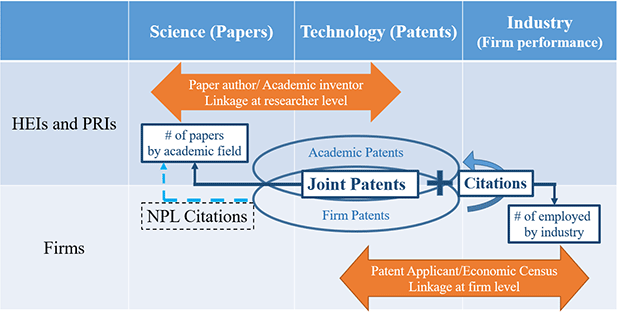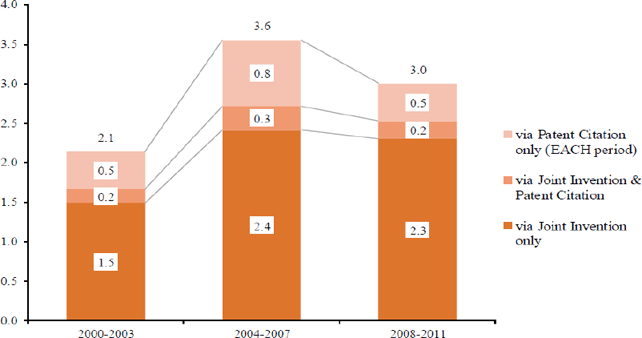The corporate sector's retreat from basic research
At the plenary session of the annual Technology and Innovation Management (TIM) conference of the Academy of Management (AOM) held in Atlanta in August 2017, discussions were held based on a paper that has created a stir in academic circles ("The Decline of Science in Corporate R&D," Arora et. al (2015)). This paper analyzed the cause of the trend of U.S. companies retreating from basic research and pouring efforts into development, which has been observed over the past three decades. As the contributing factors of the trend, the paper pointed to major companies' approach of target selection and resource concentration (focusing on applications development in specific fields, rather than on basic research), the rise of China and other emerging countries and intensified competition (short-term orientation toward innovation), and the progress in the division of roles between companies and universities and other public research institutions engaging in basic research (division of innovative labor).
In Japan as well, companies' retreat from basic research is reflected in a decline in the number of scientific papers written by corporate authors. As someone who has conducted studies on open innovation activities, including industry-academia partnerships, it is clear from the results of questionnaire surveys and interviews with Japanese companies that the intensifying competition is influencing major companies' shift of emphasis in research and development (R&D) to applications development. Meanwhile, the importance of scientific knowledge for creating outstanding innovations is growing. Therefore, I am placing high expectations on industry-academia partnerships to make up for this basic research gap (Motohashi (2005), Motohashi, et al (2012)).
There is no doubt that there has been a recent trend where the importance of scientific knowledge for the industrial innovation process is growing. Genome science is significantly changing the pharmaceutical industry's R&D process, while understanding of the physical properties of materials at the nanoscale level has become essential to the miniaturization of the large scale integration (LSI) fabrication process. Information technology has had a huge social and economic impact, and big data analysis has brought deeper insights for business and management activities. In particular, the advance of data science can be regarded as a shift from the scientification of specific industries such as pharmaceuticals and electronics to the scientification of the whole economy, including finance and distribution, namely as a shift to a science-based economy (Motohashi, 2014).
In this era of a science-based economy, scientific and innovation activities occur simultaneously while interacting with each other unlike in the case of a linear model under which scientific knowledge is first gained at research institutions such as universities and then used by companies to develop new products. Systematically measuring a qualitative change in innovation like this through a large dataset is expected to produce useful input for not only innovation management by companies but also reform of universities and national R&D institutions and policy discussions, including on industry-academia partnerships. From this viewpoint, we are conducting analysis concerning a science-based innovation process by combining academic research paper data, patent data, and economic census data at the micro level.
Development of the dataset and measurement of science linkages
Here, I will describe the outline of our dataset based on a discussion paper written by the research team of which I was a part of and also included Kenta Ikeuchi from RIETI, Naotoshi Tsukada from NISTEP, and Ryuichi Tamura from Keio University (Ikeuchi et. al, 2017). Figure 1 is a concept image of the dataset.

In developing the dataset, we created a paper author/academic inventor linkage at the researcher level and a patent applicant/economic census linkage at the firm level (represented by the two orange arrows in Figure 1). These linkages were created on the basis of patent data. In other words, joint patents between researchers involved in both research papers and patents and companies and patents which were invented by such researchers and which were cited by corporate patents were selected. This patent-based paper linkage indicates how much science (as represented by the number of research papers) is contributing to corporate activities (as represented by the number of employees (Note)). In some cases, corporate patents directly cite academic research papers (non-patent literature citations in patents). This is a traditional indicator of science linkage, while our new indicator captures a closer interactive relationship between science and innovation.
Figure 2 shows an example of the analysis results obtained through this approach. Here, the period covered by the dataset is divided into three parts, and changes in the science linkage (represented by the number of science research papers per employee) for the industry as a whole are indicated. The number of patent applications filed by university and other academic researchers increased significantly from the first part of the period to the second part because of the impact of the incorporation of national universities in 2004, among other factors. Consequently, the science linkage grew considerably. However, in the third part of the period, which started in 2008, the value of this indicator declined. This is attributable to a decline in patent citations (of patents invented by universities and other academic institutions), in particular, and it may be presumed that there was little change from the second part of the period in the trend concerning industry-academia joint inventions. The third part of the period, 2008 to 2011, coincides with a time when companies' business performance deteriorated due to the recession that followed the collapse of Lehman Brothers, causing them to curb expenditure on innovation. Even in that situation, companies continued joint research activities with universities. Our analysis results indicate the need for companies to create innovations through a close relationship with scientific activities in the academic world. When we look at the results on an industry-by-industry basis, we can see that science linkage was strengthened throughout the period of analysis in many industries, including chemicals (excluding pharmaceuticals), electrical machinery, and electronic devices. Meanwhile, the variance across industries is narrowing, confirming that a shift to a science-based economy, namely, scientification of the whole economy, is ongoing.
(Average number of linked academic publications per 100 employees)

Implications and future studies
There are various forms of industry-academia partnerships. As well as joint studies between universities and companies, dispatch of corporate researchers to universities and in-licensing of intellectual property owned by universities can be regarded as a form of industry-academia partnership in the broad sense of the term. From the viewpoint of commercialization of public research results (innovation) achieved by universities, creating university-derived venture companies is also an option. If a closer and more interactive relationship with universities and other public research institutions engaging in scientific research activities is important, a form of partnership under which companies are more actively involved in implementing joint research, rather than leaving the initiative entirely to universities, will be effective. It will also be effective if universities are more actively involved in innovation activities through the creation of university-derived venture companies, for example.
In terms of policy, our analysis results suggest the importance of measures to promote companies' hands-on involvement in industry-academia partnerships. It will also be important to create a subsidy scheme for research projects implemented under an industry-academia consortium framework and to promote institutional initiatives in both the business and academic worlds to make it easier for companies to dispatch researchers to universities. In addition, while reform of the R&D-related tax system has been implemented to strengthen the incentive for open innovation R&D activities, it is important to further enhance the incentive. Meanwhile, concerning universities and national research institutions, it is necessary to consider institutional measures to enhance these public research institutions' role so that they can function as hubs of the innovation ecosystem (Motohashi and Kang, 2016). Concerning university-derived venture companies and the innovation ecosystem, we are continuing a study using the above mentioned dataset. We are planning to publish the results of the study gradually through discussion papers.


